Human Resource Management: Motivation Theories and Employee Turnover
VerifiedAdded on 2023/06/18
|7
|2070
|388
Essay
AI Summary
This essay delves into the critical aspects of Human Resource Management, focusing on motivation theories and the factors contributing to employee turnover. It outlines three motivation process theories—Vroom's Expectancy Theory, Adam's Equity Theory, and Skinner's Reinforcement Theory—discussing their roles in enhancing employee motivation and workplace dynamics. Furthermore, the essay identifies and elaborates on six key factors responsible for high employee turnover, including inadequate salary, lack of flexibility, insufficient recognition, limited career advancement opportunities, poor communication, and lack of autonomy. The analysis emphasizes the importance of addressing these factors to foster employee satisfaction, reduce turnover rates, and improve overall organizational performance. Desklib provides access to similar solved assignments and study tools for students.
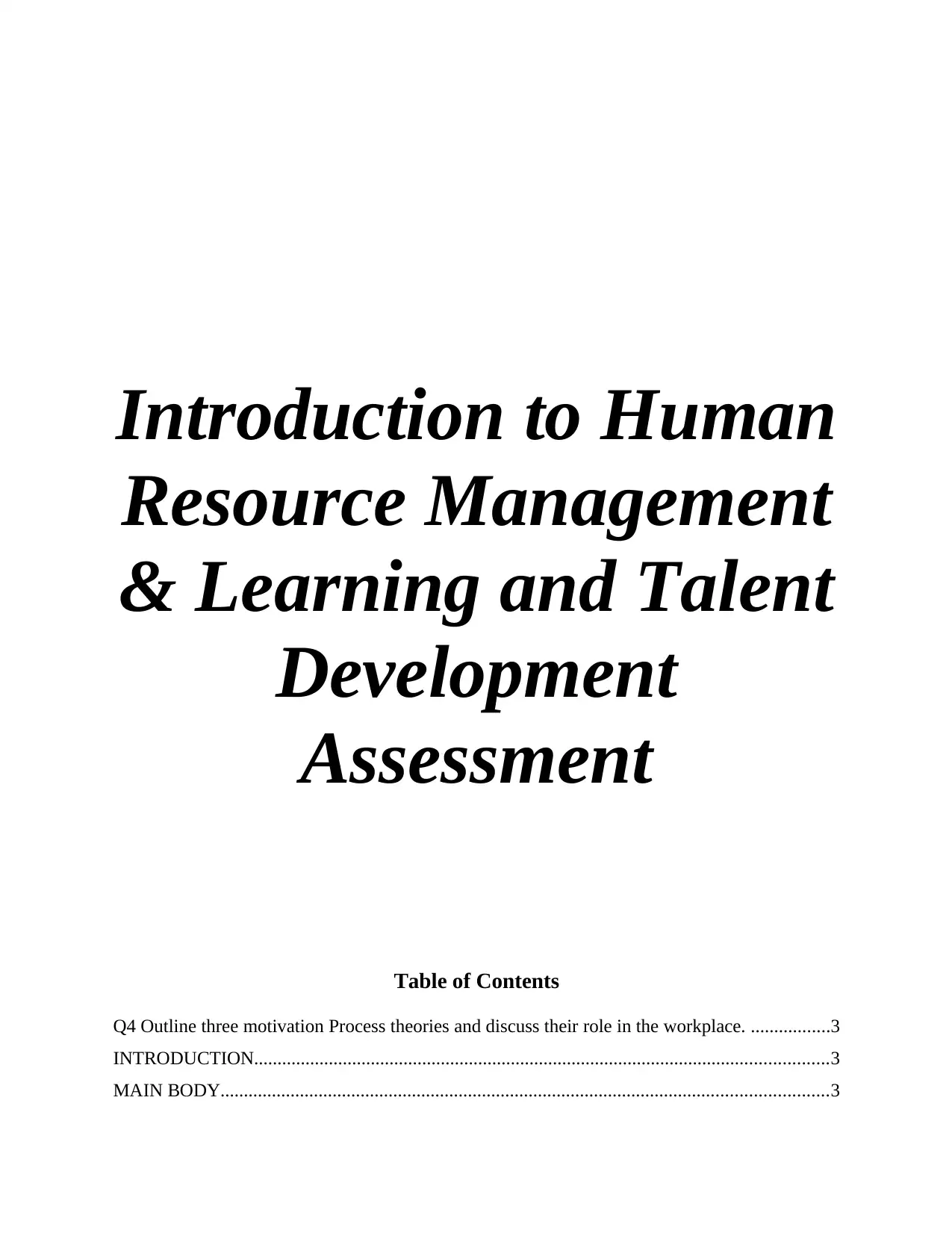
Introduction to Human
Resource Management
& Learning and Talent
Development
Assessment
Table of Contents
Q4 Outline three motivation Process theories and discuss their role in the workplace. .................3
INTRODUCTION...........................................................................................................................3
MAIN BODY..................................................................................................................................3
Resource Management
& Learning and Talent
Development
Assessment
Table of Contents
Q4 Outline three motivation Process theories and discuss their role in the workplace. .................3
INTRODUCTION...........................................................................................................................3
MAIN BODY..................................................................................................................................3
Paraphrase This Document
Need a fresh take? Get an instant paraphrase of this document with our AI Paraphraser
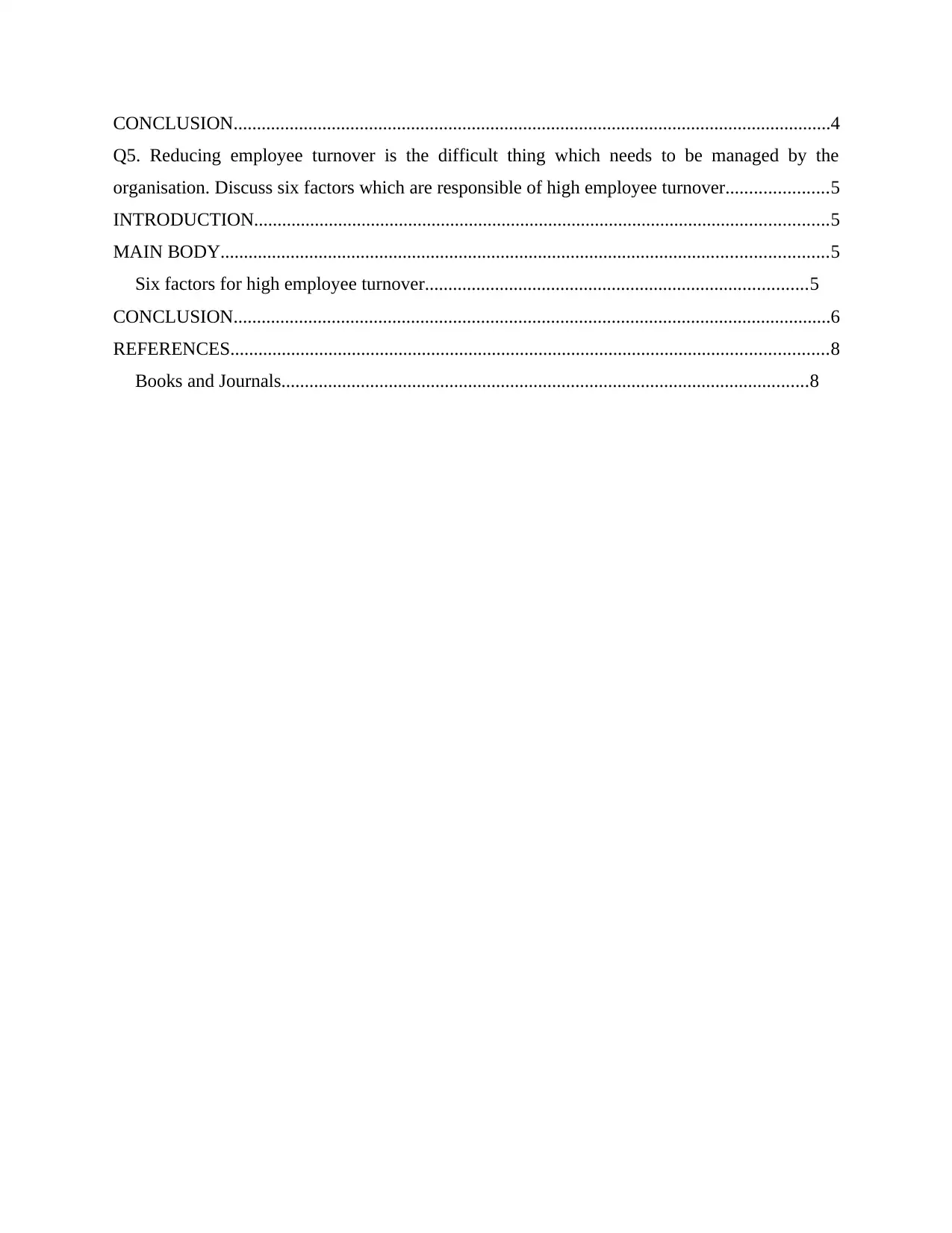
CONCLUSION................................................................................................................................4
Q5. Reducing employee turnover is the difficult thing which needs to be managed by the
organisation. Discuss six factors which are responsible of high employee turnover......................5
INTRODUCTION...........................................................................................................................5
MAIN BODY..................................................................................................................................5
Six factors for high employee turnover..................................................................................5
CONCLUSION................................................................................................................................6
REFERENCES................................................................................................................................8
Books and Journals.................................................................................................................8
Q5. Reducing employee turnover is the difficult thing which needs to be managed by the
organisation. Discuss six factors which are responsible of high employee turnover......................5
INTRODUCTION...........................................................................................................................5
MAIN BODY..................................................................................................................................5
Six factors for high employee turnover..................................................................................5
CONCLUSION................................................................................................................................6
REFERENCES................................................................................................................................8
Books and Journals.................................................................................................................8
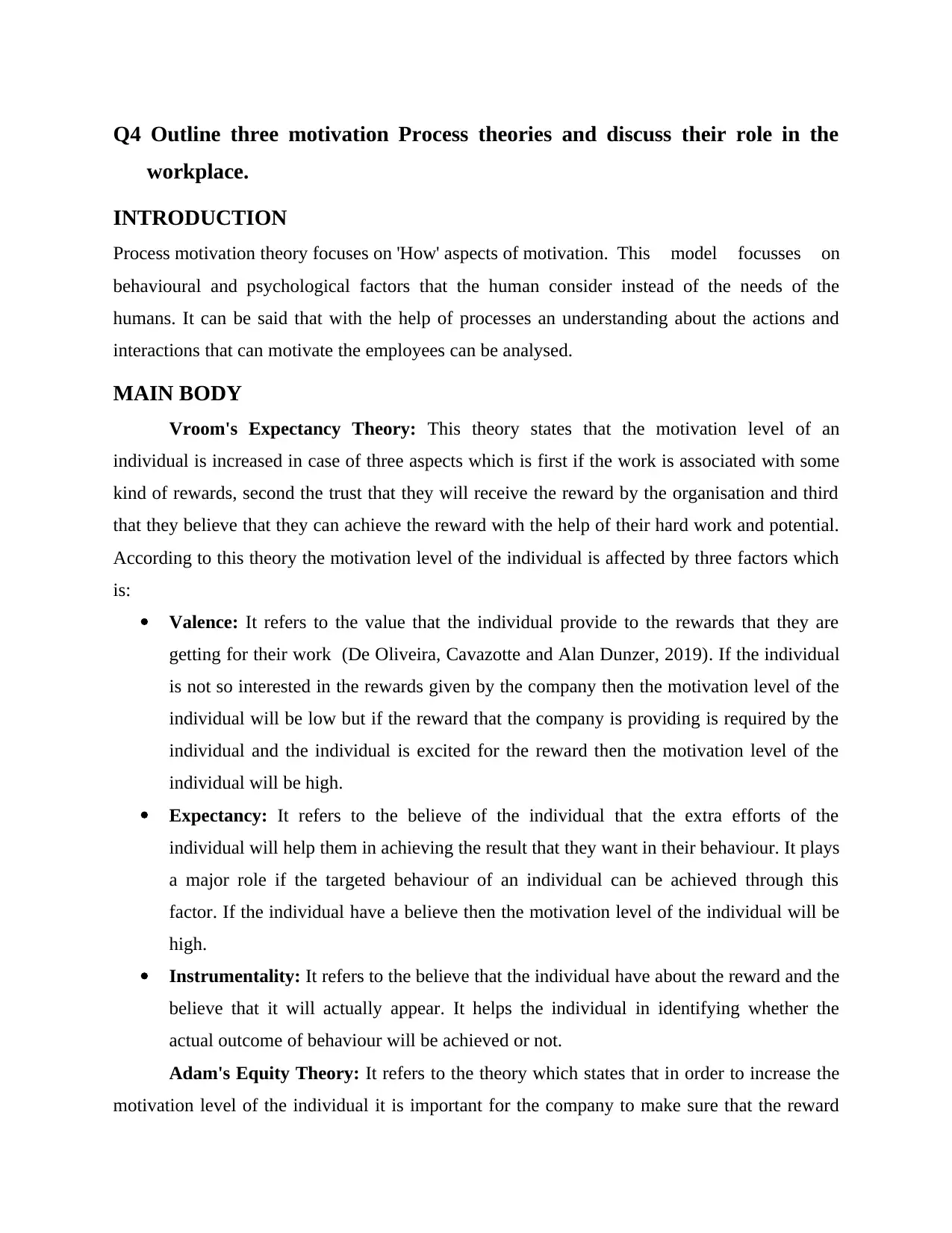
Q4 Outline three motivation Process theories and discuss their role in the
workplace.
INTRODUCTION
Process motivation theory focuses on 'How' aspects of motivation. This model focusses on
behavioural and psychological factors that the human consider instead of the needs of the
humans. It can be said that with the help of processes an understanding about the actions and
interactions that can motivate the employees can be analysed.
MAIN BODY
Vroom's Expectancy Theory: This theory states that the motivation level of an
individual is increased in case of three aspects which is first if the work is associated with some
kind of rewards, second the trust that they will receive the reward by the organisation and third
that they believe that they can achieve the reward with the help of their hard work and potential.
According to this theory the motivation level of the individual is affected by three factors which
is:
Valence: It refers to the value that the individual provide to the rewards that they are
getting for their work (De Oliveira, Cavazotte and Alan Dunzer, 2019). If the individual
is not so interested in the rewards given by the company then the motivation level of the
individual will be low but if the reward that the company is providing is required by the
individual and the individual is excited for the reward then the motivation level of the
individual will be high.
Expectancy: It refers to the believe of the individual that the extra efforts of the
individual will help them in achieving the result that they want in their behaviour. It plays
a major role if the targeted behaviour of an individual can be achieved through this
factor. If the individual have a believe then the motivation level of the individual will be
high.
Instrumentality: It refers to the believe that the individual have about the reward and the
believe that it will actually appear. It helps the individual in identifying whether the
actual outcome of behaviour will be achieved or not.
Adam's Equity Theory: It refers to the theory which states that in order to increase the
motivation level of the individual it is important for the company to make sure that the reward
workplace.
INTRODUCTION
Process motivation theory focuses on 'How' aspects of motivation. This model focusses on
behavioural and psychological factors that the human consider instead of the needs of the
humans. It can be said that with the help of processes an understanding about the actions and
interactions that can motivate the employees can be analysed.
MAIN BODY
Vroom's Expectancy Theory: This theory states that the motivation level of an
individual is increased in case of three aspects which is first if the work is associated with some
kind of rewards, second the trust that they will receive the reward by the organisation and third
that they believe that they can achieve the reward with the help of their hard work and potential.
According to this theory the motivation level of the individual is affected by three factors which
is:
Valence: It refers to the value that the individual provide to the rewards that they are
getting for their work (De Oliveira, Cavazotte and Alan Dunzer, 2019). If the individual
is not so interested in the rewards given by the company then the motivation level of the
individual will be low but if the reward that the company is providing is required by the
individual and the individual is excited for the reward then the motivation level of the
individual will be high.
Expectancy: It refers to the believe of the individual that the extra efforts of the
individual will help them in achieving the result that they want in their behaviour. It plays
a major role if the targeted behaviour of an individual can be achieved through this
factor. If the individual have a believe then the motivation level of the individual will be
high.
Instrumentality: It refers to the believe that the individual have about the reward and the
believe that it will actually appear. It helps the individual in identifying whether the
actual outcome of behaviour will be achieved or not.
Adam's Equity Theory: It refers to the theory which states that in order to increase the
motivation level of the individual it is important for the company to make sure that the reward
⊘ This is a preview!⊘
Do you want full access?
Subscribe today to unlock all pages.

Trusted by 1+ million students worldwide
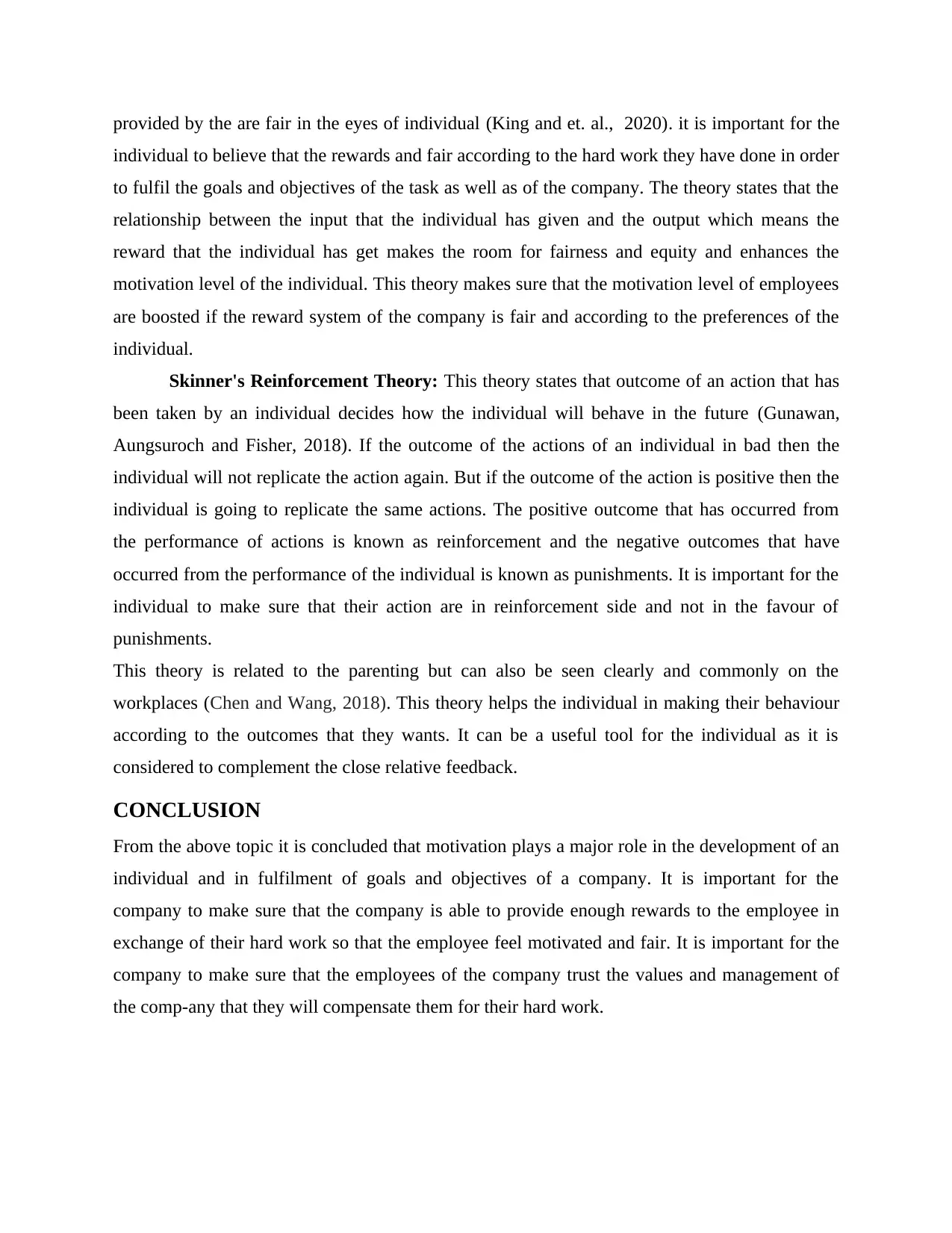
provided by the are fair in the eyes of individual (King and et. al., 2020). it is important for the
individual to believe that the rewards and fair according to the hard work they have done in order
to fulfil the goals and objectives of the task as well as of the company. The theory states that the
relationship between the input that the individual has given and the output which means the
reward that the individual has get makes the room for fairness and equity and enhances the
motivation level of the individual. This theory makes sure that the motivation level of employees
are boosted if the reward system of the company is fair and according to the preferences of the
individual.
Skinner's Reinforcement Theory: This theory states that outcome of an action that has
been taken by an individual decides how the individual will behave in the future (Gunawan,
Aungsuroch and Fisher, 2018). If the outcome of the actions of an individual in bad then the
individual will not replicate the action again. But if the outcome of the action is positive then the
individual is going to replicate the same actions. The positive outcome that has occurred from
the performance of actions is known as reinforcement and the negative outcomes that have
occurred from the performance of the individual is known as punishments. It is important for the
individual to make sure that their action are in reinforcement side and not in the favour of
punishments.
This theory is related to the parenting but can also be seen clearly and commonly on the
workplaces (Chen and Wang, 2018). This theory helps the individual in making their behaviour
according to the outcomes that they wants. It can be a useful tool for the individual as it is
considered to complement the close relative feedback.
CONCLUSION
From the above topic it is concluded that motivation plays a major role in the development of an
individual and in fulfilment of goals and objectives of a company. It is important for the
company to make sure that the company is able to provide enough rewards to the employee in
exchange of their hard work so that the employee feel motivated and fair. It is important for the
company to make sure that the employees of the company trust the values and management of
the comp-any that they will compensate them for their hard work.
individual to believe that the rewards and fair according to the hard work they have done in order
to fulfil the goals and objectives of the task as well as of the company. The theory states that the
relationship between the input that the individual has given and the output which means the
reward that the individual has get makes the room for fairness and equity and enhances the
motivation level of the individual. This theory makes sure that the motivation level of employees
are boosted if the reward system of the company is fair and according to the preferences of the
individual.
Skinner's Reinforcement Theory: This theory states that outcome of an action that has
been taken by an individual decides how the individual will behave in the future (Gunawan,
Aungsuroch and Fisher, 2018). If the outcome of the actions of an individual in bad then the
individual will not replicate the action again. But if the outcome of the action is positive then the
individual is going to replicate the same actions. The positive outcome that has occurred from
the performance of actions is known as reinforcement and the negative outcomes that have
occurred from the performance of the individual is known as punishments. It is important for the
individual to make sure that their action are in reinforcement side and not in the favour of
punishments.
This theory is related to the parenting but can also be seen clearly and commonly on the
workplaces (Chen and Wang, 2018). This theory helps the individual in making their behaviour
according to the outcomes that they wants. It can be a useful tool for the individual as it is
considered to complement the close relative feedback.
CONCLUSION
From the above topic it is concluded that motivation plays a major role in the development of an
individual and in fulfilment of goals and objectives of a company. It is important for the
company to make sure that the company is able to provide enough rewards to the employee in
exchange of their hard work so that the employee feel motivated and fair. It is important for the
company to make sure that the employees of the company trust the values and management of
the comp-any that they will compensate them for their hard work.
Paraphrase This Document
Need a fresh take? Get an instant paraphrase of this document with our AI Paraphraser
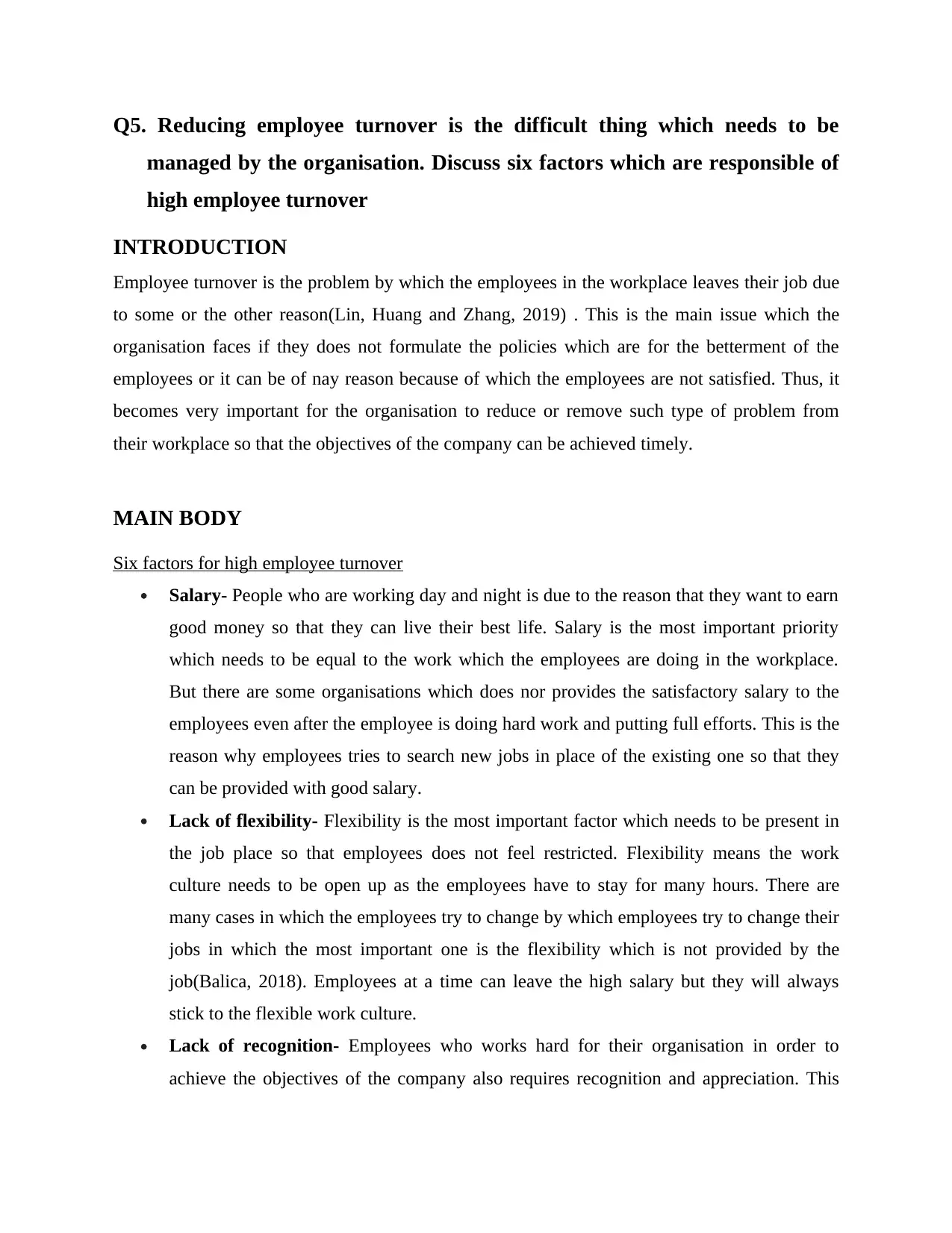
Q5. Reducing employee turnover is the difficult thing which needs to be
managed by the organisation. Discuss six factors which are responsible of
high employee turnover
INTRODUCTION
Employee turnover is the problem by which the employees in the workplace leaves their job due
to some or the other reason(Lin, Huang and Zhang, 2019) . This is the main issue which the
organisation faces if they does not formulate the policies which are for the betterment of the
employees or it can be of nay reason because of which the employees are not satisfied. Thus, it
becomes very important for the organisation to reduce or remove such type of problem from
their workplace so that the objectives of the company can be achieved timely.
MAIN BODY
Six factors for high employee turnover
Salary- People who are working day and night is due to the reason that they want to earn
good money so that they can live their best life. Salary is the most important priority
which needs to be equal to the work which the employees are doing in the workplace.
But there are some organisations which does nor provides the satisfactory salary to the
employees even after the employee is doing hard work and putting full efforts. This is the
reason why employees tries to search new jobs in place of the existing one so that they
can be provided with good salary.
Lack of flexibility- Flexibility is the most important factor which needs to be present in
the job place so that employees does not feel restricted. Flexibility means the work
culture needs to be open up as the employees have to stay for many hours. There are
many cases in which the employees try to change by which employees try to change their
jobs in which the most important one is the flexibility which is not provided by the
job(Balica, 2018). Employees at a time can leave the high salary but they will always
stick to the flexible work culture.
Lack of recognition- Employees who works hard for their organisation in order to
achieve the objectives of the company also requires recognition and appreciation. This
managed by the organisation. Discuss six factors which are responsible of
high employee turnover
INTRODUCTION
Employee turnover is the problem by which the employees in the workplace leaves their job due
to some or the other reason(Lin, Huang and Zhang, 2019) . This is the main issue which the
organisation faces if they does not formulate the policies which are for the betterment of the
employees or it can be of nay reason because of which the employees are not satisfied. Thus, it
becomes very important for the organisation to reduce or remove such type of problem from
their workplace so that the objectives of the company can be achieved timely.
MAIN BODY
Six factors for high employee turnover
Salary- People who are working day and night is due to the reason that they want to earn
good money so that they can live their best life. Salary is the most important priority
which needs to be equal to the work which the employees are doing in the workplace.
But there are some organisations which does nor provides the satisfactory salary to the
employees even after the employee is doing hard work and putting full efforts. This is the
reason why employees tries to search new jobs in place of the existing one so that they
can be provided with good salary.
Lack of flexibility- Flexibility is the most important factor which needs to be present in
the job place so that employees does not feel restricted. Flexibility means the work
culture needs to be open up as the employees have to stay for many hours. There are
many cases in which the employees try to change by which employees try to change their
jobs in which the most important one is the flexibility which is not provided by the
job(Balica, 2018). Employees at a time can leave the high salary but they will always
stick to the flexible work culture.
Lack of recognition- Employees who works hard for their organisation in order to
achieve the objectives of the company also requires recognition and appreciation. This
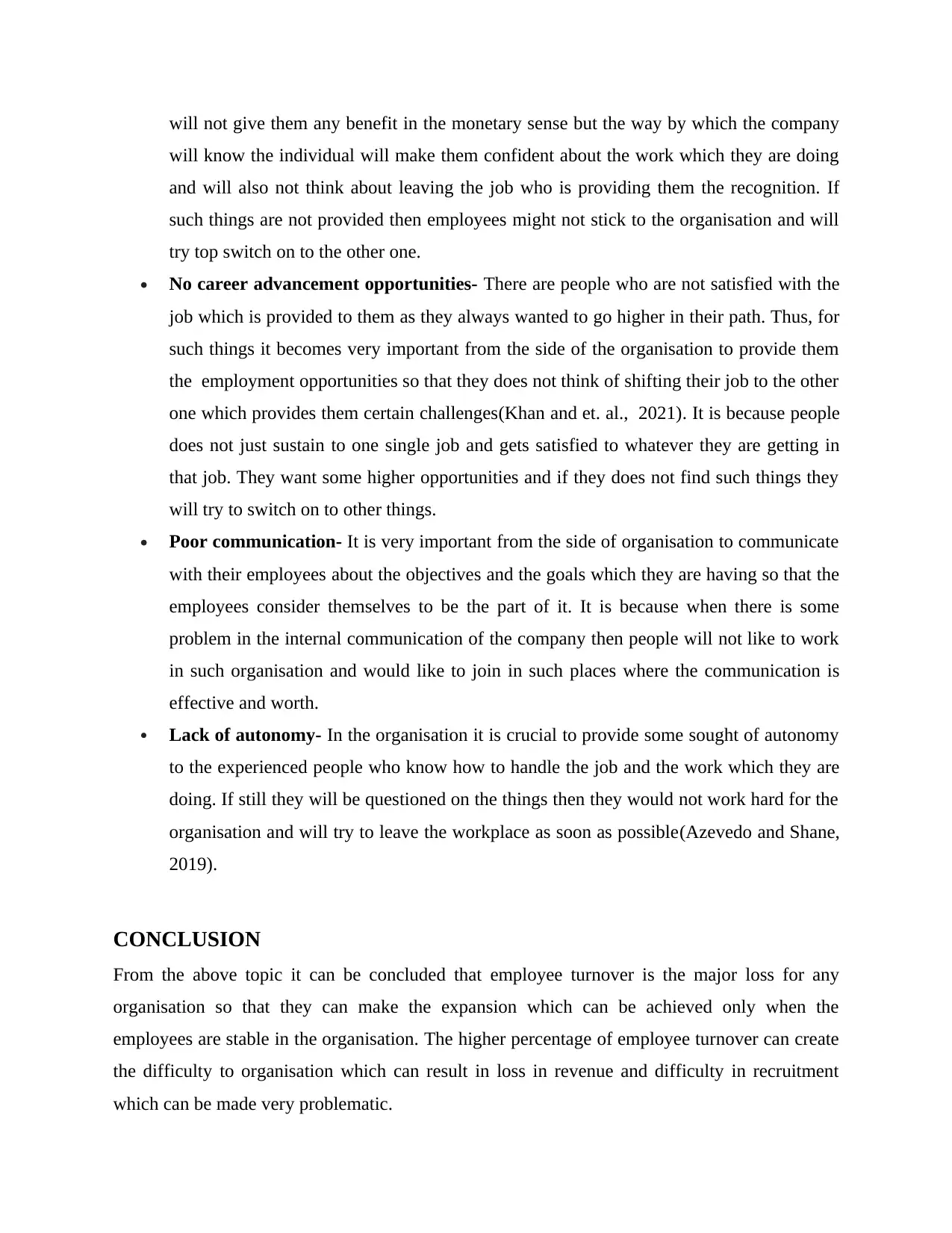
will not give them any benefit in the monetary sense but the way by which the company
will know the individual will make them confident about the work which they are doing
and will also not think about leaving the job who is providing them the recognition. If
such things are not provided then employees might not stick to the organisation and will
try top switch on to the other one.
No career advancement opportunities- There are people who are not satisfied with the
job which is provided to them as they always wanted to go higher in their path. Thus, for
such things it becomes very important from the side of the organisation to provide them
the employment opportunities so that they does not think of shifting their job to the other
one which provides them certain challenges(Khan and et. al., 2021). It is because people
does not just sustain to one single job and gets satisfied to whatever they are getting in
that job. They want some higher opportunities and if they does not find such things they
will try to switch on to other things.
Poor communication- It is very important from the side of organisation to communicate
with their employees about the objectives and the goals which they are having so that the
employees consider themselves to be the part of it. It is because when there is some
problem in the internal communication of the company then people will not like to work
in such organisation and would like to join in such places where the communication is
effective and worth.
Lack of autonomy- In the organisation it is crucial to provide some sought of autonomy
to the experienced people who know how to handle the job and the work which they are
doing. If still they will be questioned on the things then they would not work hard for the
organisation and will try to leave the workplace as soon as possible(Azevedo and Shane,
2019).
CONCLUSION
From the above topic it can be concluded that employee turnover is the major loss for any
organisation so that they can make the expansion which can be achieved only when the
employees are stable in the organisation. The higher percentage of employee turnover can create
the difficulty to organisation which can result in loss in revenue and difficulty in recruitment
which can be made very problematic.
will know the individual will make them confident about the work which they are doing
and will also not think about leaving the job who is providing them the recognition. If
such things are not provided then employees might not stick to the organisation and will
try top switch on to the other one.
No career advancement opportunities- There are people who are not satisfied with the
job which is provided to them as they always wanted to go higher in their path. Thus, for
such things it becomes very important from the side of the organisation to provide them
the employment opportunities so that they does not think of shifting their job to the other
one which provides them certain challenges(Khan and et. al., 2021). It is because people
does not just sustain to one single job and gets satisfied to whatever they are getting in
that job. They want some higher opportunities and if they does not find such things they
will try to switch on to other things.
Poor communication- It is very important from the side of organisation to communicate
with their employees about the objectives and the goals which they are having so that the
employees consider themselves to be the part of it. It is because when there is some
problem in the internal communication of the company then people will not like to work
in such organisation and would like to join in such places where the communication is
effective and worth.
Lack of autonomy- In the organisation it is crucial to provide some sought of autonomy
to the experienced people who know how to handle the job and the work which they are
doing. If still they will be questioned on the things then they would not work hard for the
organisation and will try to leave the workplace as soon as possible(Azevedo and Shane,
2019).
CONCLUSION
From the above topic it can be concluded that employee turnover is the major loss for any
organisation so that they can make the expansion which can be achieved only when the
employees are stable in the organisation. The higher percentage of employee turnover can create
the difficulty to organisation which can result in loss in revenue and difficulty in recruitment
which can be made very problematic.
⊘ This is a preview!⊘
Do you want full access?
Subscribe today to unlock all pages.

Trusted by 1+ million students worldwide
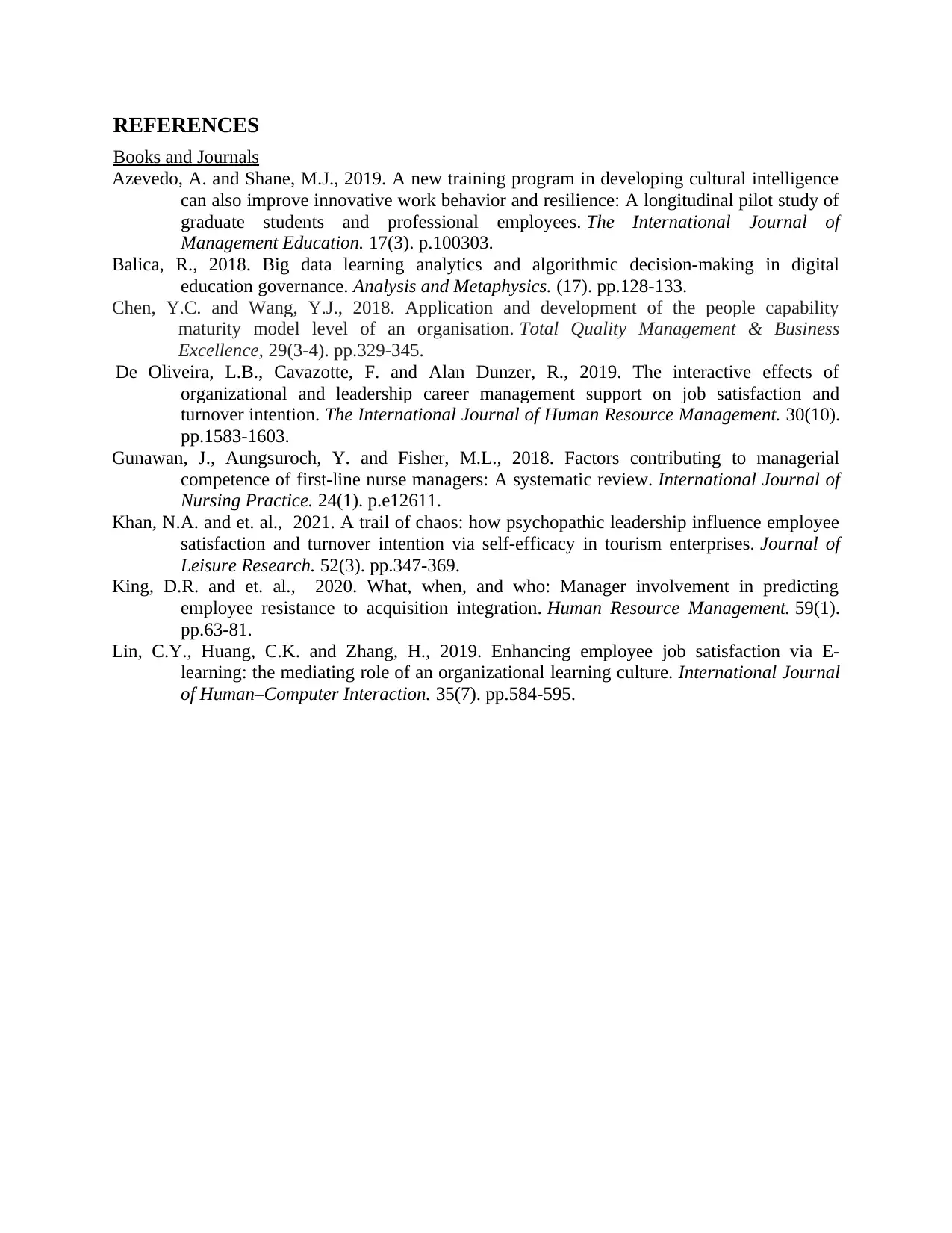
REFERENCES
Books and Journals
Azevedo, A. and Shane, M.J., 2019. A new training program in developing cultural intelligence
can also improve innovative work behavior and resilience: A longitudinal pilot study of
graduate students and professional employees. The International Journal of
Management Education. 17(3). p.100303.
Balica, R., 2018. Big data learning analytics and algorithmic decision-making in digital
education governance. Analysis and Metaphysics. (17). pp.128-133.
Chen, Y.C. and Wang, Y.J., 2018. Application and development of the people capability
maturity model level of an organisation. Total Quality Management & Business
Excellence, 29(3-4). pp.329-345.
De Oliveira, L.B., Cavazotte, F. and Alan Dunzer, R., 2019. The interactive effects of
organizational and leadership career management support on job satisfaction and
turnover intention. The International Journal of Human Resource Management. 30(10).
pp.1583-1603.
Gunawan, J., Aungsuroch, Y. and Fisher, M.L., 2018. Factors contributing to managerial
competence of first‐line nurse managers: A systematic review. International Journal of
Nursing Practice. 24(1). p.e12611.
Khan, N.A. and et. al., 2021. A trail of chaos: how psychopathic leadership influence employee
satisfaction and turnover intention via self-efficacy in tourism enterprises. Journal of
Leisure Research. 52(3). pp.347-369.
King, D.R. and et. al., 2020. What, when, and who: Manager involvement in predicting
employee resistance to acquisition integration. Human Resource Management. 59(1).
pp.63-81.
Lin, C.Y., Huang, C.K. and Zhang, H., 2019. Enhancing employee job satisfaction via E-
learning: the mediating role of an organizational learning culture. International Journal
of Human–Computer Interaction. 35(7). pp.584-595.
Books and Journals
Azevedo, A. and Shane, M.J., 2019. A new training program in developing cultural intelligence
can also improve innovative work behavior and resilience: A longitudinal pilot study of
graduate students and professional employees. The International Journal of
Management Education. 17(3). p.100303.
Balica, R., 2018. Big data learning analytics and algorithmic decision-making in digital
education governance. Analysis and Metaphysics. (17). pp.128-133.
Chen, Y.C. and Wang, Y.J., 2018. Application and development of the people capability
maturity model level of an organisation. Total Quality Management & Business
Excellence, 29(3-4). pp.329-345.
De Oliveira, L.B., Cavazotte, F. and Alan Dunzer, R., 2019. The interactive effects of
organizational and leadership career management support on job satisfaction and
turnover intention. The International Journal of Human Resource Management. 30(10).
pp.1583-1603.
Gunawan, J., Aungsuroch, Y. and Fisher, M.L., 2018. Factors contributing to managerial
competence of first‐line nurse managers: A systematic review. International Journal of
Nursing Practice. 24(1). p.e12611.
Khan, N.A. and et. al., 2021. A trail of chaos: how psychopathic leadership influence employee
satisfaction and turnover intention via self-efficacy in tourism enterprises. Journal of
Leisure Research. 52(3). pp.347-369.
King, D.R. and et. al., 2020. What, when, and who: Manager involvement in predicting
employee resistance to acquisition integration. Human Resource Management. 59(1).
pp.63-81.
Lin, C.Y., Huang, C.K. and Zhang, H., 2019. Enhancing employee job satisfaction via E-
learning: the mediating role of an organizational learning culture. International Journal
of Human–Computer Interaction. 35(7). pp.584-595.
1 out of 7
Related Documents
Your All-in-One AI-Powered Toolkit for Academic Success.
+13062052269
info@desklib.com
Available 24*7 on WhatsApp / Email
![[object Object]](/_next/static/media/star-bottom.7253800d.svg)
Unlock your academic potential
Copyright © 2020–2025 A2Z Services. All Rights Reserved. Developed and managed by ZUCOL.





